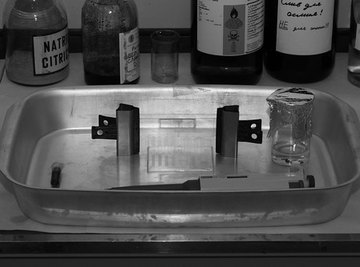
Electrophoresis is a way of separating biological molecules in an electric field based on the fact that different molecules have different natural electric charges associated with them. This causes the different components of a substance to move at different rates under the influence of an electric field. Imagine having a collection of small pieces of different metals on a tray, and placing a magnet at one end of the tray. The different chunks of metal (equalivalent to the "molecules") would be attracted to the magnet to different degrees based on their specific charges. This is essentially what happens in electrophoresis, except that the molecules are not initially separated.
Various types of electrophoresis are in practice today.
The Principle of Electrophoresis
The reason electrophoresis works is owed to one of the fundamental equations in the physics of electromagnetism: force equals electric charge times the strength of the field at that point. This assumes the form:
F = qE
Where F = force, q = electric charge and E = electric field strength.
This equation implies that the higher the charge on a particle, the stronger the force that results from the application of a given electric field. This means that two particles of the same mass but different charges will move at different rates through the field. In addition, the speed at which any charged molecule moves is dependent on its charge-to-mass ratio. Together, these properties and relationships make it possible for scientists to separate the components of critical biomolecules, such as nucleic acids, into their smaller components.
Gel Electrophoresis
Three principal types of gel electrophoresis are in use. Starch gel electrophoresis, which makes use of potato starch granules, is something of a relic. In agarose gel electrophoresis, a purified, large molecular weight polysaccharide is used as the medium; this is commonly used for large DNA molecules. Polyacrylamide gel electrophoresis is the most common type because it is extremely stable and works over a large range of molecule concentrations.
Less Commonly Used Types of Electrophoresis
Gel electrophoresis of some sort is preferred in most experimental situations. Other common modalities include high-resolution electrophoresis, capillary electrophoresis, isoelectric focusing, immunochemical electrophoresis, two-dimensional electrophoresis and pulsed field electrophoresis.
Types of Electrophoresis Set-Ups
The instrumentation of electrophoresis makes as much of a difference as the specific medium used. In the old days, boundary electrophoresis was the standard. In this experimental setup, the rate of movement of the whole boundary of the migrating molecules is measured. Today, zone electrophoresis is more common, with molecules migrating to different areas, or zones, on a small region of paper. This is a more targeted approach than boundary electrophoresis. Finally, paper electrophoresis is sometimes used for small molecules.
References
About the Author
Kevin Beck holds a bachelor's degree in physics with minors in math and chemistry from the University of Vermont. Formerly with ScienceBlogs.com and the editor of "Run Strong," he has written for Runner's World, Men's Fitness, Competitor, and a variety of other publications. More about Kevin and links to his professional work can be found at www.kemibe.com.
Photo Credits
Image by Flickr.com, courtesy of Sergei Golyshev
